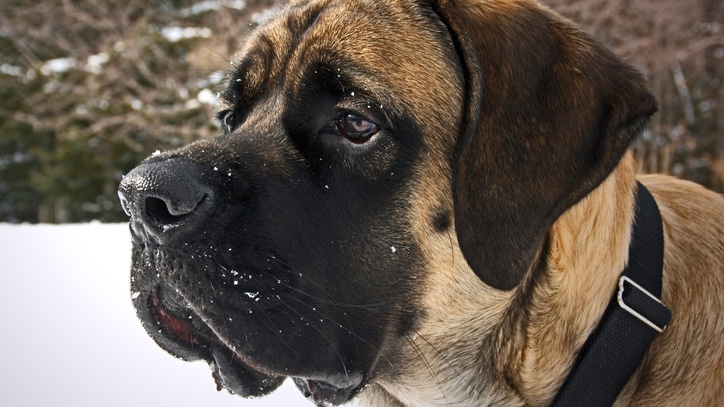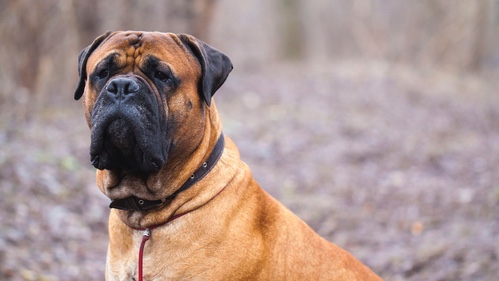English Mastiff Dog Breed profile
English Mastiff dogs are big, loyal and affectionate dogs but they sure need lots of space

English Mastiffs are big dogs. In fact, one English Mastiff became so big, he earned himself a Guinness World Records entry as the heaviest dog in the world, weighing a colossal 345 pounds (157kg) in 1989. But although this drooly giant is the largest of the different types of Mastiff breeds, don't be scared. English Mastiffs are gentle, friendly souls when they're well-trained and their wrinkly faces fronting their large square-shaped head are also very cute.
How they came to be isn't entirely certain but their ancestor is the Molossus and they are believed to have descended from the extinct Pugnaces Britanniae and Alaunt mixed with the Alpine Mastiff in the 1800s. They became popular guard dogs but, in the early 20th century appeared to fall out of favor, with only 24 Mastiffs registered in the US from 1906 to 1918. Their popularity only rose following World War II and now they're among the top 30 most-owned in the United States.
How much exercise does an English Mastiff need?

Life expectancy: 6-12 years
Average weight: Male: 220lbs/100kg Female: 170lbs/77kg
About the same as: A keg of beer
Exercise level: Low
English Mastiffs won't be eagerly waiting for you to take them out for a walk but it's vitally important that you do so. Rather than give in to their penchant for chilling out around your home, you'll need to exercise them for around an hour each day, taking care not to overdo it, particularly when they're fast-growing puppies and more prone to damaging their bones and joints.
In general, a gentle stroll on a leash should be enough to ensure these large dogs will use up their excess energy. Simple exercises will also develop and hone the breed's skeletal frame and muscles while providing mental stimulation – essential in helping to avoid destructive behavior. It's certainly worth supplementing an English Mastiff's walks with access to the best dog toys. You should also consider strengthening games such as tug-o-war.
Is the English Mastiff dog easy to train?
Suitable for: People with space who want a protective pet
Not suitable for: Novice dog parents with little time to train and socialize a dog
Temperament: Courageous, calm, protective, affectionate, lazy
Shedding: Moderate
English Mastiffs are well-behaved dogs so long as you've trained them well. Ideally you'd start the moment you get your new pet through the door, making sure the breed becomes sufficiently socialized around humans and other animals. Obedience training is certainly crucial. These are large dogs and most owners would struggle to have one around the home if they are not understanding or following basic commands or learning what is acceptable behavior. Luckily, they're relatively easy to train.
That said, they're not ideal for novice owners. The key is to show an English Mastiff that you are in control and if you've never owned a dog before, then you'll likely struggle to assert yourself as the leader of the pack. With large breeds such as these there definitely has to be a two-way level of respect and heaps of patience. But, by keeping training sessions short and sweet (no more than 15 minutes) and by ensuring you use positive reinforcement (these dogs are very sensitive), you'll soon overcome any stubbornness and have a loyal and obedient dog on your hands.
What do English Mastiffs eat?
English Mastiffs are couch potatoes so don't encourage them to pack on the pounds. Keep food-related treats to a minimum and ensure tasty meals intended for yourselves isn't unintentionally left in their line of sight, otherwise there's a chance they'll wolf it down the moment your back is turned.
Get the best advice, tips and top tech for your beloved Pets
Aim for about six to 10 cups of the best dry food spread across two meals each day once they reach adulthood (a little less for females) and ensure they're getting about 25% quality protein and 10% fat in their diet. Continue this right through their life because the belief that senior dogs should eat less protein is not true. Puppies will need a higher intake of protein, however.
What is the temperament of an English Mastiff?
English Mastiffs tend to be protective but polite and they're more likely to be timid, quiet and calm. But – and it's a big but – it all comes down to their training. Whenever this breed growls or shows its teeth, you need to be clear that it's not an acceptable behavior. You also need to learn what triggers them and avoid such situations otherwise you could very well have an aggressive dog on your hands.
As you can imagine, this would be far from ideal given an English Mastiff's size and power. Indeed, having this breed running towards you, snarling and threatening, is sure to be frightening, more so when you take into account the dog has a bite force of 552 psi, which is one of the strongest of all breeds. But, for all that, it's rare to see English Mastiffs attack a human and they will tend to avoid a conflict rather than go in all-teeth bearing. Just be sure to train them well!
Are English Mastiffs good family dogs?
Absolutely. If they're well-trained, you'll find the English Mastiffs are affectionate and amazing with children. Although they may remain wary of strangers and other pets, they'll look out for your family and protect them if the need arises. Perhaps avoid having an English Mastiff as a pet if you have very small children or frail older people in your household, though. You wouldn't want this breed to knock into them and potentially cause injuries.

Amount Of Shedding: Moderate
Easy To Groom: Yes
General Health: Good
Potential For Weight Gain: Moderate
English Mastiffs shed all year round with peaks in the summer and the fall. But since their coats are short-haired, you only really need to run one of the best dog brushes over the fur once or twice a week to keep on top of things.
Other than that, occasionally give this breed a bath, check their ears, keep their teeth clean and trim their nails. Oh, and wipe their face – English Mastiffs don't half drool and it can go absolutely everywhere, particularly when they shake their heads, so having some tissues or wipes to hand will certainly come in handy.
Wisdom Panel Breed Discovery DNA Kit | Amazon
Not sure exactly what breed your dog is? This kit screens for 365+ breeds – because knowing every detail about your dog helps you understand how best to care for them.
How healthy are English Mastiffs?
English Mastiffs are generally healthy – unless you count loud snoring and grunting and excess wind (that they're known for their gassiness is putting it mildly). The most common cause of death, however, is bone cancer (osteosarcoma) and there is no screening test available. English Mastiffs can also suffer from gastric torsion, or bloat, so watch out for excessive drooling and retching and seek urgent help. It's always worth taking out the best pet insurance just in case.
Should I get an English Mastiff?
In some ways, the decision could be made for you. If you live in a small apartment or house then you're going to struggle having such a large breed at home.
But if you have the space with a reasonable-sized yard and you want a strong, adorable, protective pooch that isn't very active, you should seriously consider getting an English Mastiff – unless you have small children or frail people around, that is, in which case perhaps think twice.
In general, though, so long as you have the time to train and socialize this breed, they make for a wonderful, loving and calm companion.
Read next: All about the bullmastiff or compare English Mastiff vs bullmastiff

David Crookes has been a journalist for almost 30 years and he has written for a host of magazines, newspapers, websites and books including the World of Animals Annual, BBC Earth, Live Science, The Independent and Tom’s Guide.
Born in England, he lives with two cats but he’s also keenly interested in the differences between the huge number of dog breeds – in fact, you can read many of his breed guides that he’s written in collaboration with vets here on PetsRadar.
With a lifelong passion for technology, too, he’s always on the lookout for useful devices that will allow people to keep their pets happier and healthier, and provide them more time to spend together.
David has a degree from Durham University, as well as postgraduate diploma in journalism from the University of Central Lancashire.

